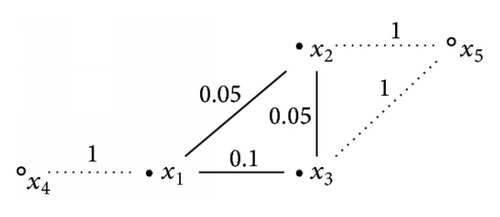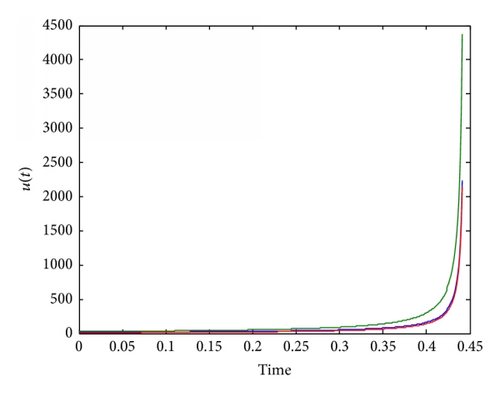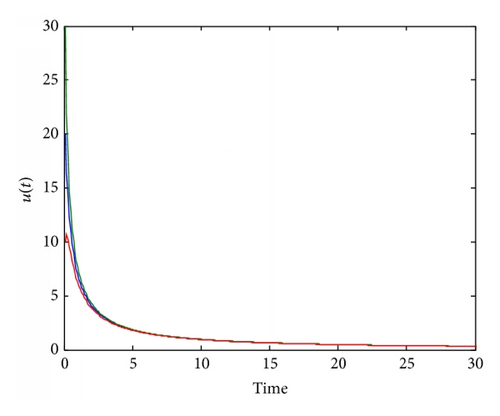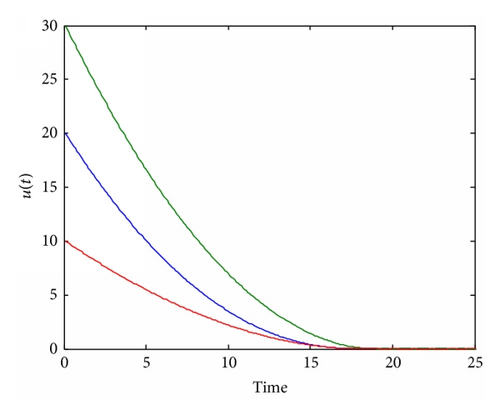Critical Blow-Up and Global Existence for Discrete Nonlinear p-Laplacian Parabolic Equations
Abstract
The goal of this paper is to investigate the blow-up and the global existence of the solutions to the discrete p-Laplacian parabolic equation ut(x, t) = Δp,wu(x, t) + λ|u(x, t)|p−2u(x, t), (x, t) ∈ S × (0, ∞), u(x, t) = 0, (x, t) ∈ ∂S × (0, ∞), u(x, 0) = u0, depending on the parameters p > 1 and λ > 0. Besides, we provide several types of the comparison principles to this equation, which play a key role in the proof of the main theorems. In addition, we finally give some numerical examples which exploit the main results.
1. Introduction
The continuous case of (3) has been studied by many authors. For example, the case where 1 < p < 2 was studied in [3, 6] and the case where p > 2 was studied in [3, 4].
For the discrete case of (1), the authors studied the general theory of the equation for the case p = 2 in [8] and Xin et al. studied the blow-up solutions and global solutions for the case where p = 2 and λ = 1 in [9]. On the other hand, for the case λ ≤ 0 in (1), Chung et al. [10, 11] investigate the positive solutions and extinctive solutions, depending on the parameters p and q. But, the case where p > 1 and λ > 0 in (3) has not been studied yet. Thus, the purpose of this paper is to give a complete solution to such a problem about (3).
The main results of this paper are summarized as follows.
Theorem 1. (i) For p > 2 and λ > λ0, the solution to
Here, λ0 is the first eigenvalue of the p-Laplace operator Δp,w on S. Moreover, it is shown that the blow-up rate of the solution is estimated by
(ii) For p > 2 and λ ≤ λ0, the solution to (4) is global, for every nonnegative initial data u0.
(iii) For 1 < p ≤ 2, the nonnegative solution to (4) is global for every nonnegative initial data u0. In particular, when 1 < p < 2 and λ < λ0, there exists T > 0 (extinction time) such that u(x, t) ≡ 0 for all t ≥ T.
Besides, we provide several types of the comparison principles to (4) in Section 2, which play a key role in the proof of the main theorems and we give some numerical examples in the final section which exploit the main results.
2. Preliminaries and Discrete Comparison Principles
In this section, we start with some definitions of graph theoretic notions frequently used throughout this paper (see [8, 12, 13] for more details).
For a graph G = G(V, E) we mean finite sets V of vertices (or nodes) with a set E of two-element subsets of V (whose elements are called edges). The set of vertices and edges of a graph G is sometimes denoted by V(G) and E(G), or simply V and E, respectively. Conventionally, we denote by x ∈ V or x ∈ G the facts that x is a vertex in G.
A graph G is said to be simple if it has neither multiple edges nor loops, and G is said to be connected if, for every pair of vertices x and y, there exists a sequence (called a path) of vertices x = x0, x1, …, xn−1, xn = y such that xj−1 and xj are connected by an edge (called adjacent) for j = 1, …, n.
A graph S = S(V′, E′) is said to be a subgraph of G(V, E) if V′ ⊂ V and E′ ⊂ E.
- (i)
ω(x, x) = 0, x ∈ V,
- (ii)
ω(x, y) = ω(y, x) if x ~ y,
- (iii)
ω(x, y) = 0 if and only if x≁y.
Here, x ~ y means that two vertices x and y are connected (adjacent) by an edge in E. A graph associated with a weight is said to be a weight graph or a network.
The following lemmas are useful throughout this paper.
Lemma 3 (see [14], [15].)For p > 1, there exist λ0 > 0 and ϕ0(x) > 0, x ∈ S, such that
In the above, the number λ0 is called the first eigenvalue of Δp,ω on a network with corresponding eigenfunction ϕ0 (see [12, 13] for the spectral theory of the Laplacian operators).
Now, we state the comparison principles and some related corollaries.
Theorem 4. Let T > 0 (T may be +∞), λ > 0, and p ≥ 2. Suppose that real-valued functions u(x, ·), v(x, ·) ∈ C[0, T) are differentiable in (0, T) for each and satisfy
Proof. Let T′ > 0 be arbitrarily given with T′ < T. Then by the mean value theorem, for each x ∈ S and 0 ≤ t ≤ T′,
Then inequality (13) can be written as
Now, we obtain a strict comparison principle as a corollary.
Corollary 5 (strict comparison principle). In Theorem 4, if u0(x*) > v0(x*) for some x* ∈ S, then u(x, t) > v(x, t) for all (x, t) ∈ S × (0, T).
Proof. First, note that u ≥ v on by Theorem 4. Let T′ > 0 be arbitrarily given with T′ < T and let be a function defined by
Then inequality (21) gives
For the case 1 < p < 2, it is well known that (10) may not have unique solution, in general, and the comparison principle in usual form as in Theorem 4 may not hold. Instead, with a strict condition on the parabolic boundary we obtain a similar comparison principle as follows.
Theorem 6. Let T > 0 (T may be +∞), λ > 0, and p > 1. Suppose that real-valued functions u(x, ·), v(x, ·) ∈ C[0, T are differentiable in (0, T) for each and satisfy
Proof. Let T′ > 0 and δ > 0 be arbitrarily given with T′ < T and 0 < δ < min(x,t)∈Γ[u(x, t) − v(x, t)], respectively, where (called a parabolic boundary).
Now, let a function be a function defined by
- (i)
τ(x0, t0) = 0,
- (ii)
τ(y, t0) ≥ τ(x0, t0) = 0, y ∈ S,
- (iii)
τ(x, t) > 0, (x, t) ∈ S × (0, t0).
Then
3. Blow-Up and Global Existence
Definition 7 (blow-up). We say that a solution u to an equation defined on a network blows up in finite time T, if there exists x ∈ S such that |u(x, t)|→+∞ as t↗T−.
Theorem 8. For p > 2 and λ > 0, the solution to
Proof. First, we note that u(x, t) > 0 on S × (0, ∞), by the strict comparison principle (Corollary 5). Now, we define a functional by
Multiplying (36) by u and summing up over , we obtain from Lemma 2
Remark 9. (i) Condition (37) implies that
(ii) The initial data u0 with J(0) > 0 always exists. In fact, consider an eigenvalue λ0 > 0 and eigenfunction ϕ0(x) > 0 in Lemma 3. Taking u0(x) = ϕ0(x), then we have
(iii) When the solution to (37) is global, then we must have
(iv) The blow-up time in the above can be estimated roughly. Taking
Now, we state the main theorem as follows.
Theorem 10. The solution to (36) with p > 2 and λ > λ0 blows up in finite time, for every nonnegative and nontrivial initial data u0.
Proof. First, we note that (36) has a unique solution such that
Remark 11. According to Remark 9 (iv) to Theorem 8, the blow-up time for the solution to (36) is estimated by
We now derive the lower bound for the maximum function of blow-up solutions.
Theorem 12. Let u be the solutions to (36) blowing up at finite time T. Then it follows that
Proof. For each t > 0, let xt ∈ S be the node such that
Now define a function by
Now, we state the global existence of the solutions.
Theorem 13. For p > 2 and λ ≤ λ0, the solution to (36) is global for every nonnegative initial data u0.
Proof. Consider an eigenvalue λ0 > 0 and eigenfunction ϕ0(x) > 0 in Lemma 3 and v(x, t)∶ = Kϕ0(x), , t ≥ 0. Then by taking K large enough to be Kϕ0(x) ≥ u0(x), x ∈ S, we have
We have so far discussed the blow-up or the global existence (35) for the case p ≥ 2. Now, we discuss the case 1 < p ≤ 2. Here, we note that when 1 < p < 2, the solution to the equation may not have unique positive solution.
Theorem 14. For 1 < p ≤ 2, the nonnegative solution to
Proof. First, consider ODE
Now, assume 1 < p < 2 and λ < λ0. When u is a trivial solution, then we are done. So now we assume that u is nontrivial. Multiplying (73) by u, as done in (40), we have
4. Examples and Numerical Illustrations
In this section, we show numerical illustrations to exploit our results in the previous section.

Example 1. For (36) on (Figure 1) graph with p = 3, λ = 1.1, consider initial data given by u0(x1) = 20, u0(x2) = 30, and u0(x3) = 10. Then by easy calculation, we get the first eigenvalue λ0 = 1 < λ = 1.1 and the corresponding eigenfunction ϕ0(x1) = ϕ0(x2) = ϕ0(x3)≒0.6934. Figure 2 shows that the solution to (36) blows up and the computed blow-up time T is estimated as T≒0.4433079.
On the other hand, consider the same equation (36) with p = 3, λ = 0.9 and the same initial data. Then λ = 0.9 < λ0 = 1 and Figure 3 shows that the solution to (36) is global.


Example 2. For (36) on (Figure 1) graph with p = 1.5, λ = 0.5, and the same initial data u0 given by u0(x1) = 20, u0(x2) = 30, and u0(x3) = 10, then Figure 4 shows that the solution to (36) is global and extinctive.

Conflict of Interests
The author declares that there is no conflict of interests regarding the publication of this paper.
Acknowledgments
This work was supported by the National Research Foundation of Korea (NRF) grant funded by the Korean government (MOE) (no. 2012R1A1A2004689) and Sogang University Research Grant of 2014 (no. 201410044).




